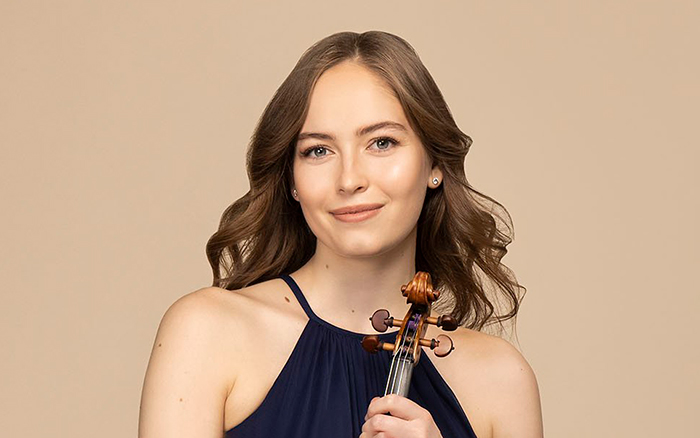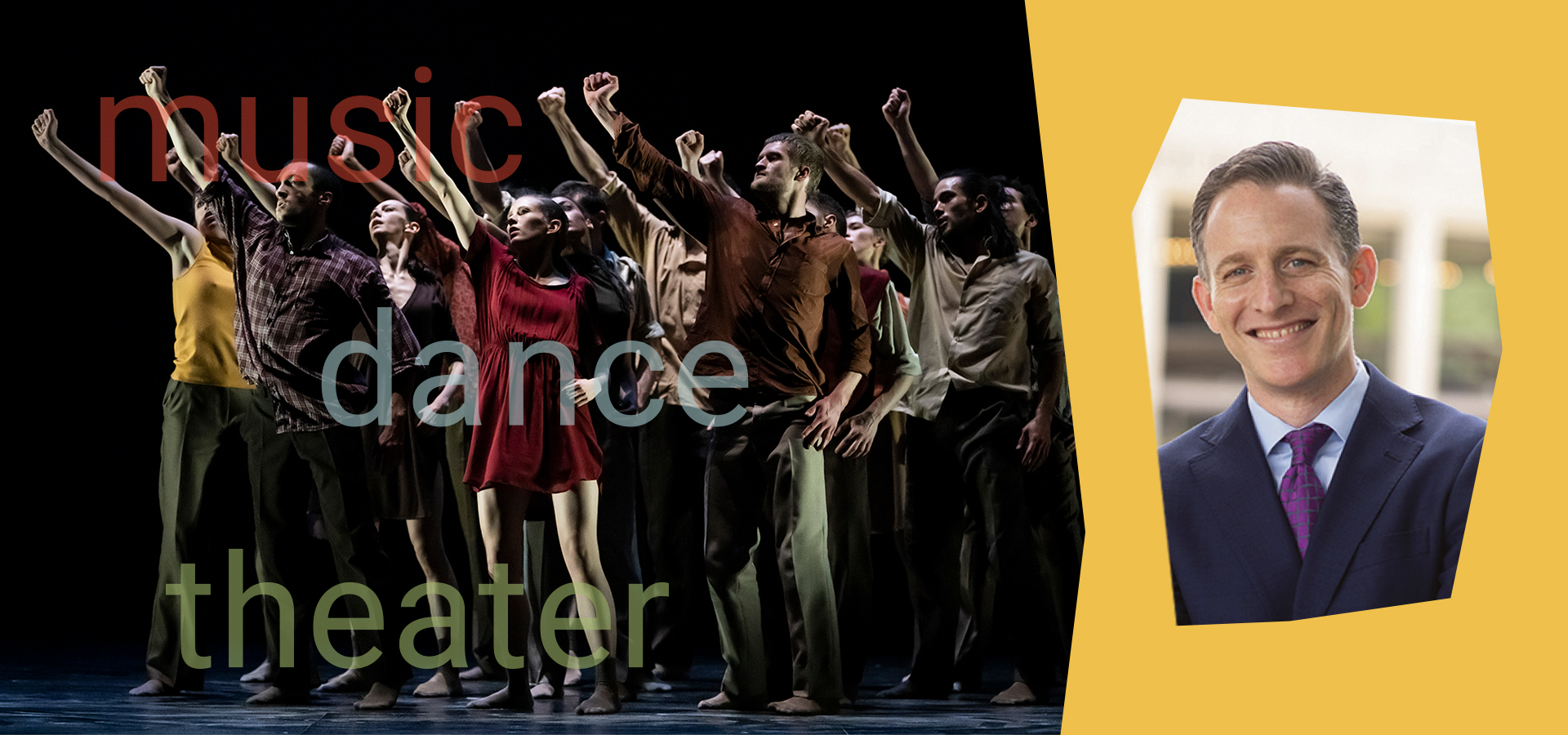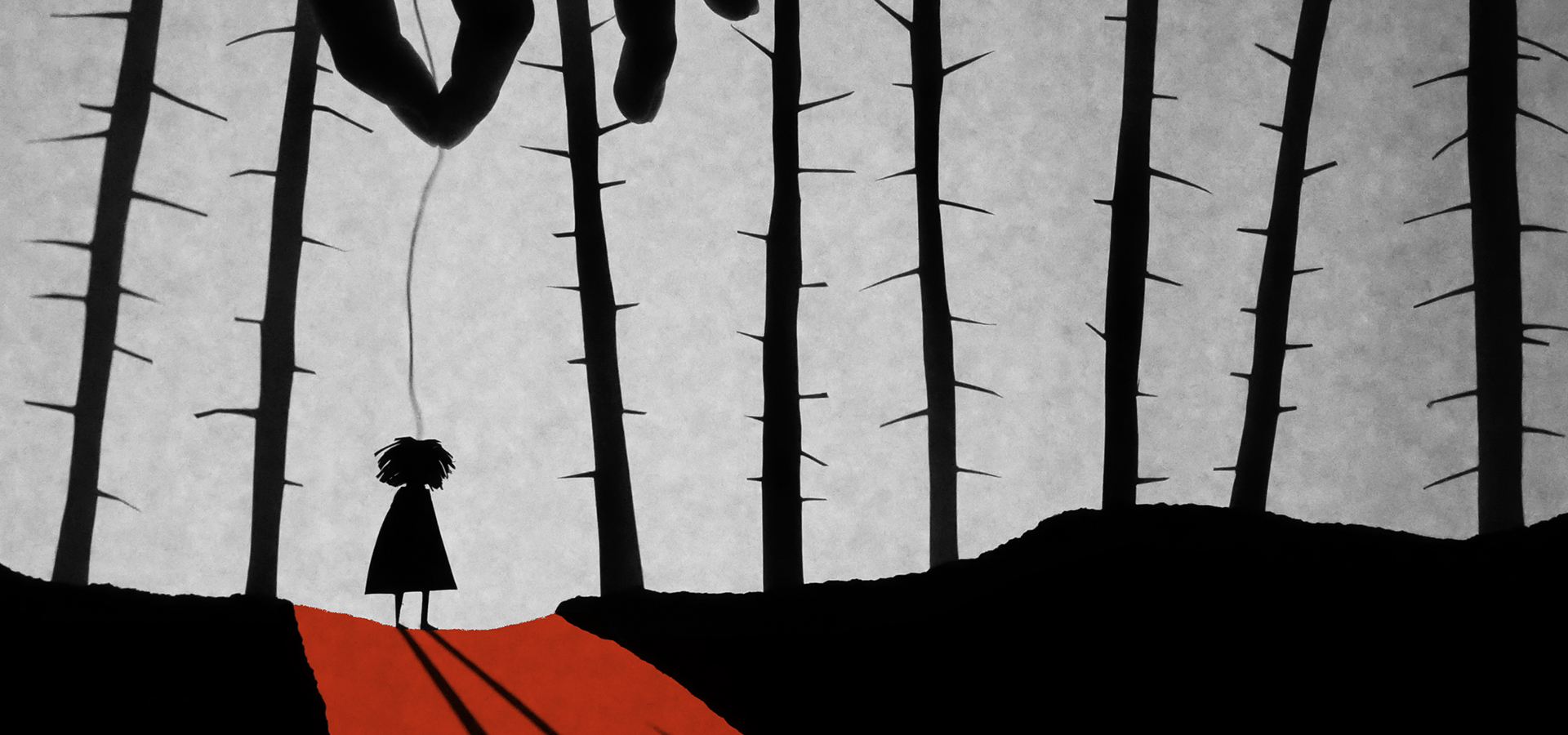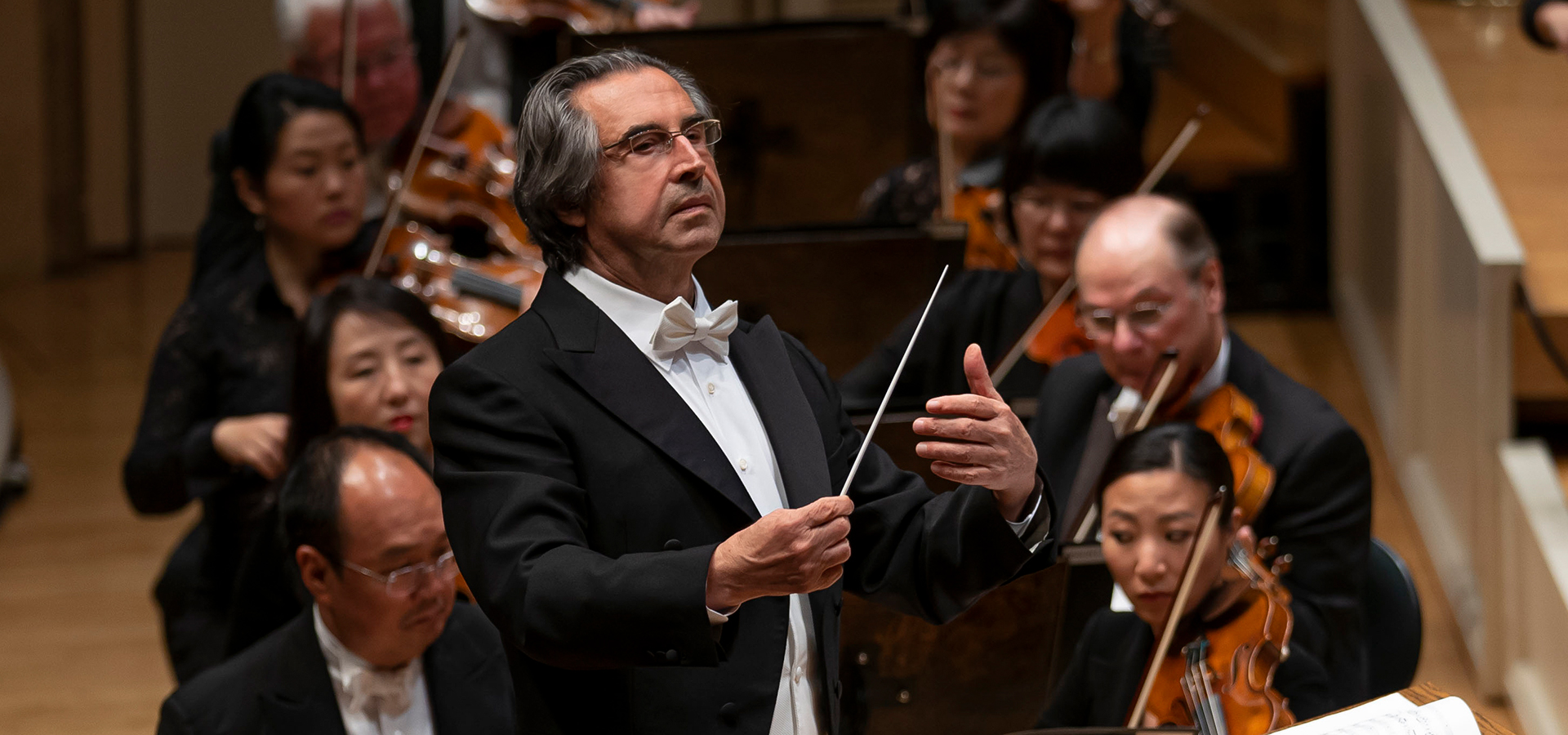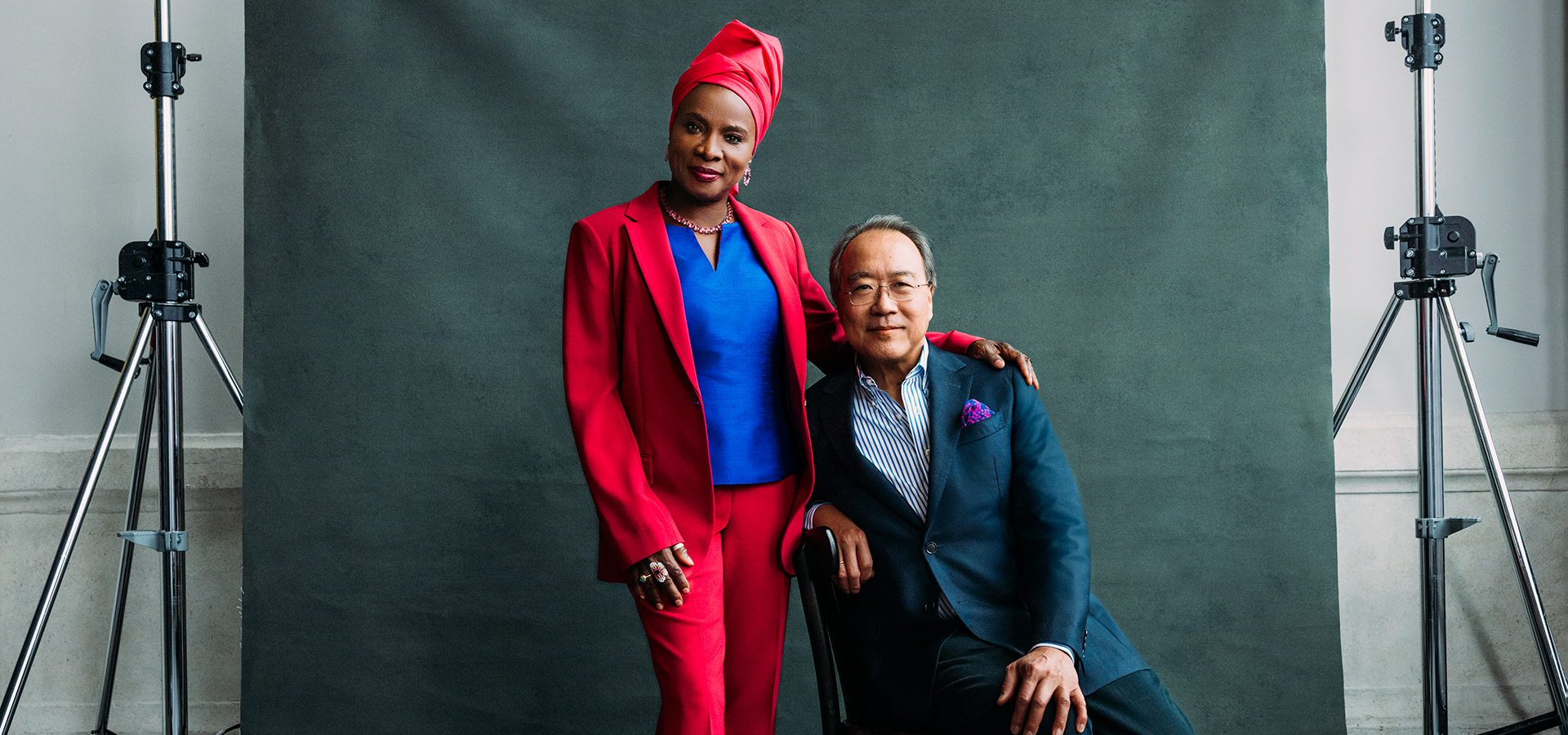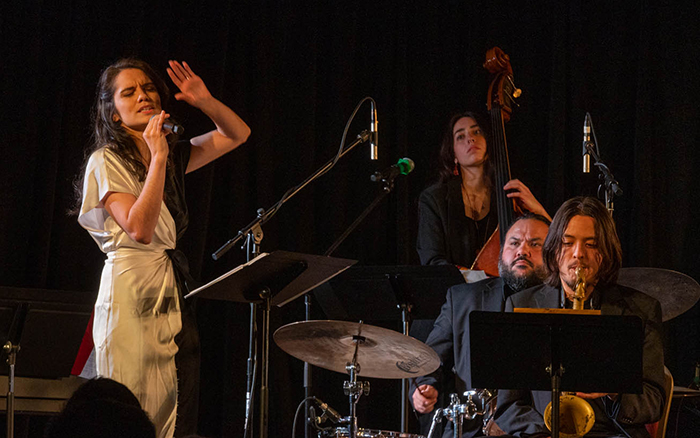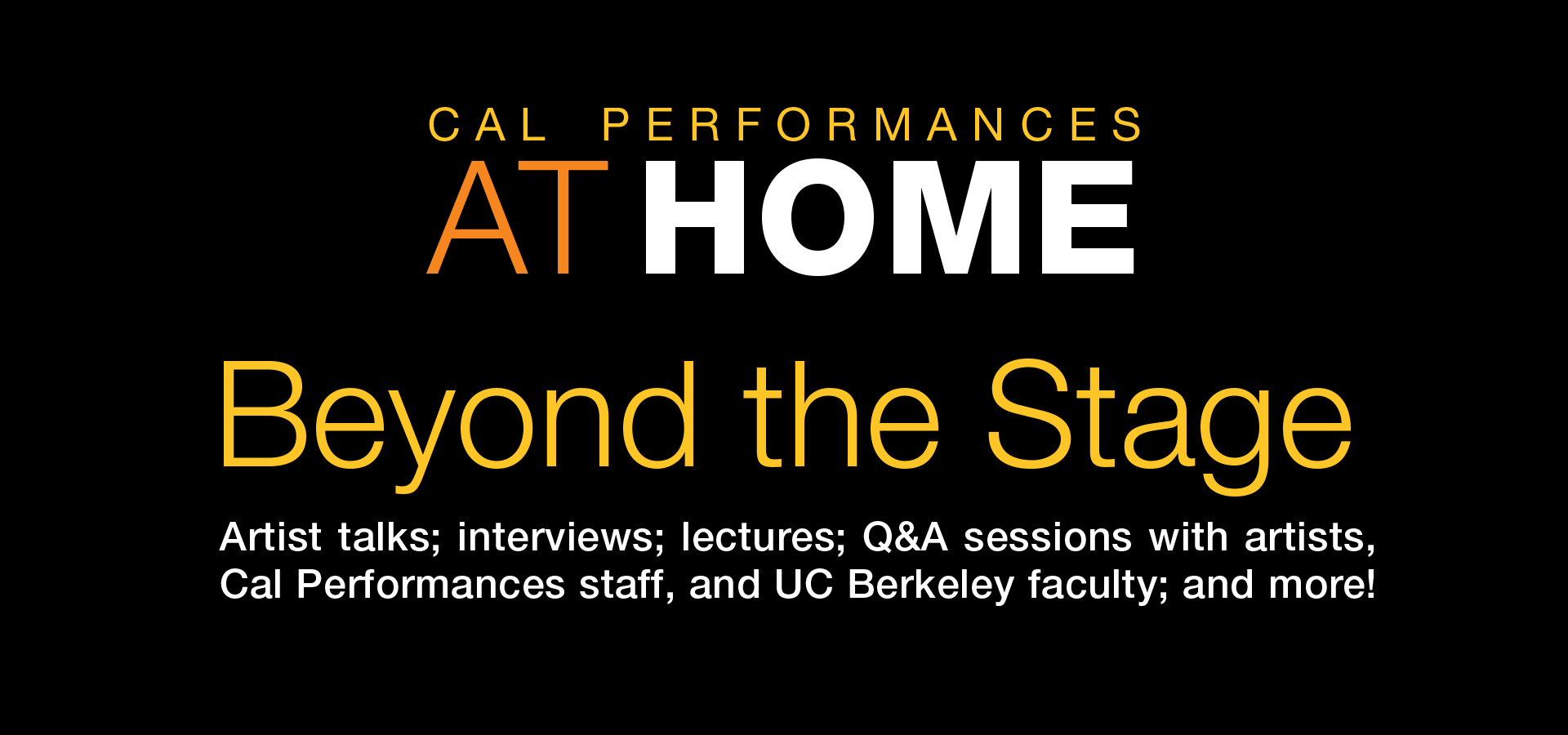
Cal Performances at Home is much more than a series of great streamed performances. Fascinating behind-the-scenes artist interviews. Informative and entertaining public forums. The Cal Performances Reading Room, featuring books with interesting connections to our Fall 2020 programs. For all this and much more, keep checking this page for frequent updates and to journey far, far Beyond the Stage!
Major support for Beyond the Stage is provided by Bank of America.
Beyond the Stage
“The Best Things Come in Pairs”: A Deep-Dive into Recitalist Partnerships for the 2025-26 Season

“The Best Things Come in Pairs”: A Deep-Dive into Recitalist Partnerships for the 2025-26 Season
Artists share the secret to what makes each of their partnerships so successful, and give us one word to describe their pairing.
By Angelina Josephine Rosete, Cal Performances’ Engagement Writer
Recital partnerships occupy a unique space in classical music; they rely on a deeply personal, negotiated relationship between two artists, unlike larger staged productions where roles and responsibilities are often more clearly defined. What audiences witness onstage is the product of conversation, study, mutual trust, and artistic curiosity.
For many of this season’s Cal Performances recitalists, these partnerships began long before the first downbeat. They grew out of shared values, mutual admiration, and an intuitive sense that their counterpart could illuminate something new within the music. Their reflections offer insight into how collaboration evolves, how performers listen, and how—in the best partnerships—each artist expands the expressive possibilities of the other.


“Supportive”
When mezzo-soprano Samantha Hankey and pianist Myra Huang met at the 2018 Operalia Competition, the environment was high-pressure; yet, they found an immediate artistic kinship. Hankey recalls, “Myra is an incredibly sensitive pianist, and I felt so much support from her, both while she was playing and when she wasn’t. We immediately formed this really strong connection and appreciation for performing with one another, even in a high-stress competition setting.”
Years later, when Huang proposed performing Dichterliebe from a female perspective, Hankey says she “had to say yes for the opportunity to work together again on such an interesting project.” On working together, Huang shares that “When [Sam] is committed, she is committed. To me, that is priceless.”
Their rehearsals, often limited by distance between different cities, are marked by a careful preparation and a sense of safety with one another. Hankey explains, “We do so much prep work on our own… when we do get to be together, we actually can have fun, explore, and truly discover. It comes from a very safe place, and with an enormous sense of trust and respect in one another.” Onstage, this partnership transforms, as both artists respond to each other and to the audience in real time. Huang notes, “Sam and I are instinctive performers, so that no matter how much musicality we bring to our rehearsals, we definitely surpass it once we get on stage. We both tune into the energy of the room and one another, and give all that we have in that moment.”
Hankey sums up their collaboration in one word: “Supportive. I feel like I get to support Myra and her vision with this tremendous program, and she supports me in turn.”
Bay Area audiences can experience Huang playing alongside mezzo-soprano Samantha Hankey in her Cal Performances debut on Jan 18. The two will collaborate on an inviting program that combines Robert Schumann’s aforementioned Dichterliebe song cycle with cabaret songs, lieder, and popular favorites sung in English, French, and German.
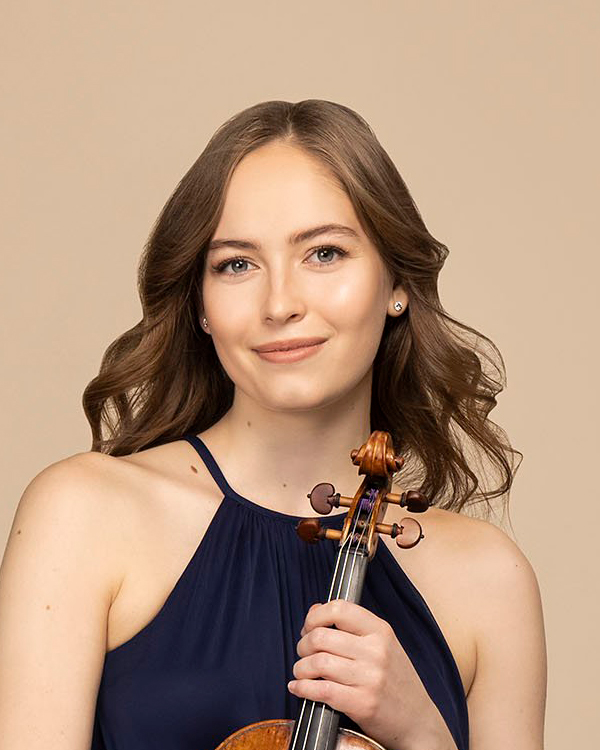
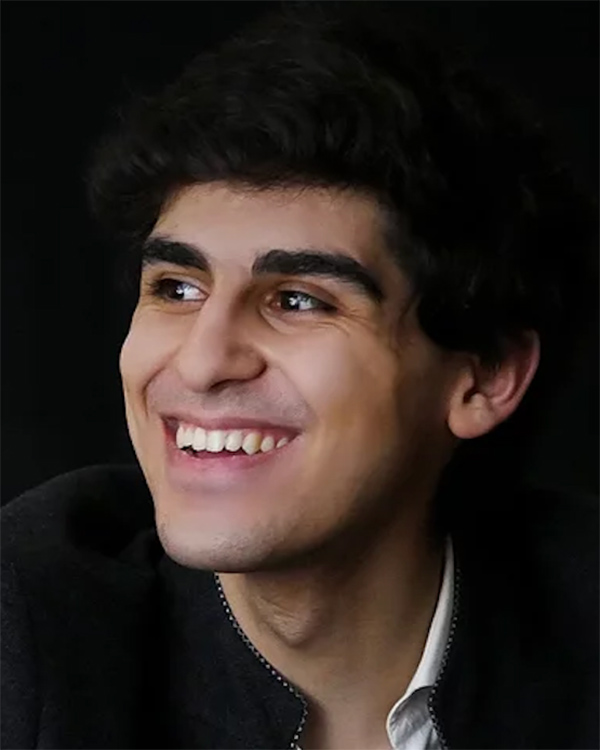
“Natural”
For violinist Geneva Lewis and pianist Evren Ozel, their partnership stretches all the way back to high school, when a shared piano trio first revealed their compatibility. Lewis recalls, “I instantly loved working with him, and I found myself really drawn to the care and effort he puts into his music, as well as his incredible sensitivity and convincing musical ideas.” In turn, Ozel recalls, “Even as high-schoolers, Geneva had this mix of generosity and fearlessness—she could lead with real expressive clarity, but she could just as easily lock in and respond.”
Their rehearsals, though often sporadic due to busy schedules and being in different cities, are both concentrated and lighthearted. Lewis shares, “We both feel comfortable sharing our musical ideas with one another and are very open to the other’s suggestions… The process is usually very relaxed, and filled with lots of jokes.” Ozel adds, “Rehearsals are concentrated and a little high-pressure; we’re both exacting, and time is limited. Performance is the release. Once we’re onstage, the preparation carries the structure, and we can actually breathe, listen, and enjoy the ride.”
In both rehearsal and performance, the duo balances their musical precision with their emotional instincts. Lewis describes their partnership in one word: “Natural. There’s a strong level of trust and understanding between us, and it has primarily formed on an intuitive level.”
Join award-winning violinist Geneva Lewis in her Cal Performances debut, joined by celebrated pianist Evren Ozel on Mar 1. Together, they present a striking program featuring a lean late-period masterpiece by Schoenberg, Bach’s E major violin sonata, Schubert’s deeply conversational Fantasy in C major, and Robert Schumann’s Violin Sonata No. 3.

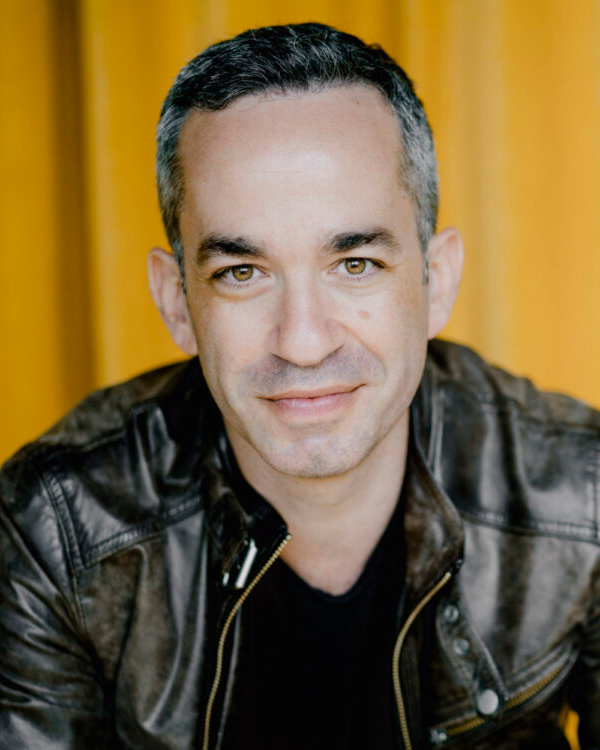
“Exciting” and “Inspiring”
World-renowned singer Renée Fleming and acclaimed pianist Inon Barnatan’s partnership began almost serendipitously; it was first on a flight to the Aspen Music Festival, where, as Fleming recalls, they were “buried in [their] scores,” yet still found themselves deep in conversation. Later that same day during a fire alarm evacuation, she introduced him to Ruth Bader Ginsburg—whom Inon had been wanting to meet—moments before their performances. Barnatan still remembers the surprise of that meeting and the even greater surprise that followed: Fleming casually asking if he might like to perform with her at Carnegie Hall that fall, a beginning he describes as “unexpected—and memorable.”
Their working relationship since has been shaped by meticulous preparation and an intuitive musical dialogue. Fleming speaks of rehearsals as a space for discovery built on “enormous, detailed preparation beforehand,” while Barnatan describes their process as “more like conversations than directives,” marked by her openness and deep familiarity with both her own part and with his. On translating these rehearsals to live performance, Barnatan remarks, “Rehearsals usually happen in small, intimate rooms, while performances are in large halls filled with hundreds or thousands of people. The sense of scale changes everything—the projection, the energy, the theatricality. But even in big spaces, we try to carry that feeling of intimacy onto a much larger canvas.”
Across these different spaces, they continue to challenge and expand one another artistically: Fleming admires Barnatan’s wide-ranging intellect and the “dialogue” it brings to their performances, and Barnatan shares that “Instrumentalists are always aspiring to sound like singers, and working with Renée is a masterclass in that ideal.”
Asked to choose a single word to describe their collaboration, Fleming offers “exciting” and Barnatan “inspiring”—two perspectives that together capture the generosity and sense of possibility that defines their partnership.
Come see legendary soprano Renée Fleming for an extraordinary recital alongside acclaimed pianist Inon Barnatan on Mar 16. The pair will share an inspired program of beloved songs, arias, and dazzling piano showpieces, offering audiences an incredible opportunity to experience one of the most celebrated voices of our time up close.
So, what makes a partnership endure? Across these duos, certain qualities recur: trust, curiosity, flexibility, and a willingness to take artistic risks. Each partnership demonstrates that collaboration is all about harnessing their differences into something more powerful—pushing each other to listen more carefully, respond more thoughtfully, and expand the expressive possibilities of the music. These recitals act as evolving conversations intertwined with displays of technical mastery; they are moments in which two artists create together, challenge each other, and invite audiences into the shared process. The stage for each artistic duo demands an unusual intimacy—two artists, shaping a shared narrative in real time. In every note and in every gesture, the audience can experience a dialogue that is equal parts precision and spontaneity, planning and discovery—a testament to the enduring power of musical partnership.
Related Events
Explore More 2025–26 Season Features
Carolling and the Spirit of Ukraine
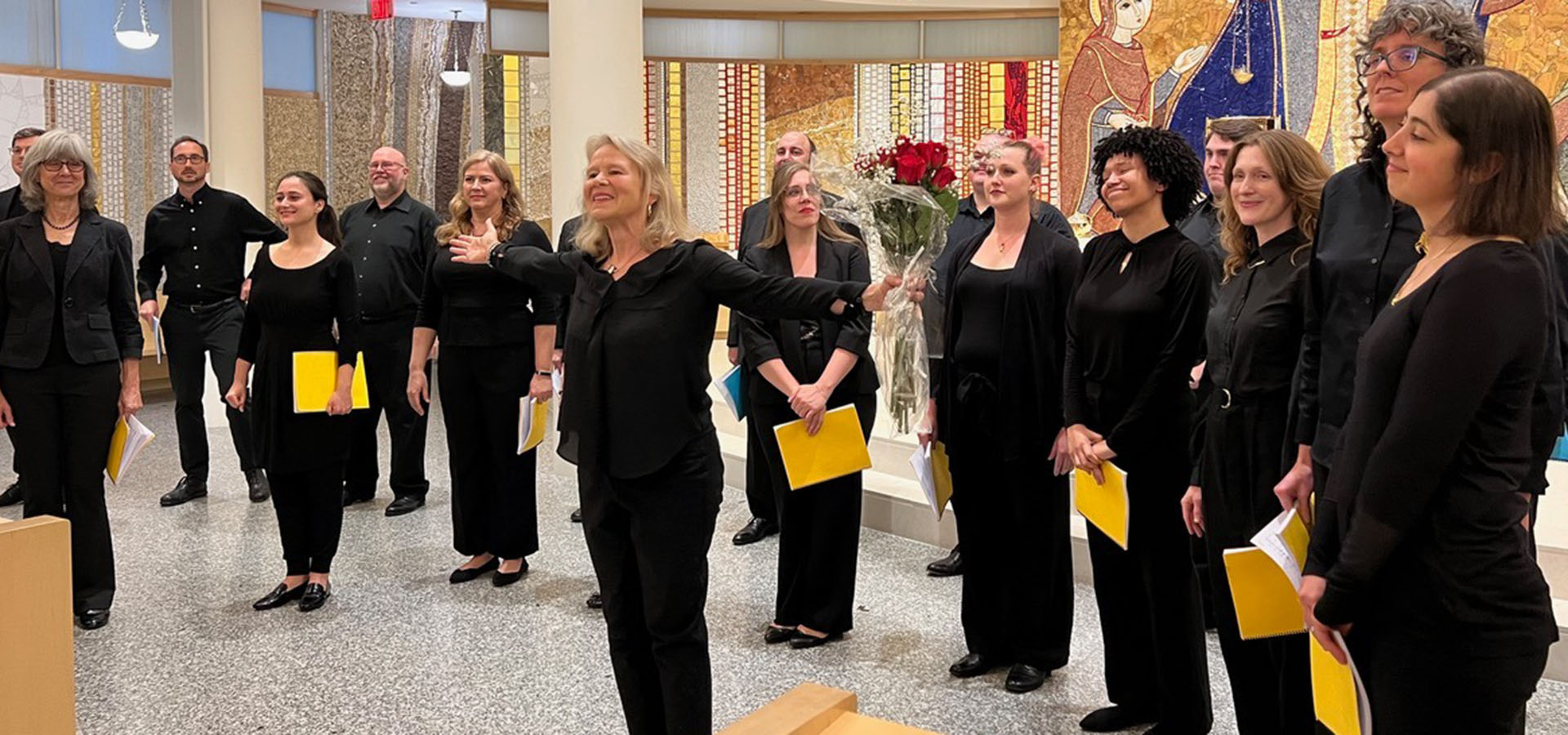
Carolling and the Spirit of Ukraine
“This isn’t music just for Ukrainians, it’s for all of us… It’s bridging the cultures. That’s kind of been my mission throughout my life, but especially now.”
Interview of Marika Kuzma; filmed and edited by El Zager, Cal Performances’ Social Media, Digital Content and Engagement Specialist
Esteemed choral director Marika Kuzma, a first-generation Ukrainian American and professor emerita of music at UC Berkeley, shares the history and tradition of Ukrainian Christmas carolling ahead of the December 13 performance of her very own Ensemble Cherubim Chamber Chorus in Carols of Birds, Bells, and Peace from Ukraine: A Holiday Celebration. Kuzma is deeply passionate about celebrating the joy and peace innate to Ukrainian culture, and here pulls from her firsthand experiences, her research, and her upcoming performance to provide insight into what makes carolling in this context so interesting and so powerful.
Sections include:
- Intro [0:00]
- What are some special holiday traditions in Ukraine? [0:27]
- Your tie to Ukraine reflects both firsthand experiences of culture, as well as scholarly research. How do those aspects shape your work? [1:18]
- What unites the members of Ensemble Cherubim around Ukraine? [2:48]
- Famed mezzo-soprano Frederica von Stade is one of a few special collaborators. What makes her a great fit for this program? [4:34]
- What should audiences know about the experience of hearing live carols for this performance? [5:28]
- What is the significance of the word “peace” in your program title? [6:34]
- What do you hope audiences will take away from the performance? [8:20]
Transcript
Introduction
Marika Kuzma:
My name is Marika Kuzma, and I’m a Ukrainian American musician, conductor, author, actor. The concert coming up [Ensemble Cherubim in Carols of Birds, Bells, and Peace from Ukraine: A Holiday Celebration on Dec 13, 2025] is going to introduce the phenomenal culture of carols from Ukraine, carols and carolling. It’s a culture that I think most Americans have not yet experienced. Even some Ukrainians, I think, it’s going to take them by surprise.
What are some special holiday traditions in Ukraine?
Singing is very much a part of Christmas Eve dinner. It’s what Ukrainians do. They sing together. And then there’s this other aspect that I think is different from what Americans experience, and that is that you sit there in darkness, and there’s just one candle. There’s this atmosphere of awe or of wonder about it. The idea is that Christmas Eve was the night when something miraculous happened. And then there’s also this sense of remembering your elders and remembering your ancestors. So there’s always a place setting for the family members who have departed. It’s an atmosphere, it’s joy, but it’s a deeper, more deeply rooted kind of joy.
Your tie to Ukraine reflects both firsthand experiences of culture, as well as scholarly research. How do those aspects shape your work?
In music scholarship, especially in ethnomusicology, there’s this idea of like, are you from within the culture or are you a great observer from outside the culture? And I feel like I’m really both, because I grew up, Ukrainian was my first language. These carols were some of the first songs I ever sang. I think I actually sang before I spoke—at least that’s what my mother told me, that I was singing before I actually could talk. So it’s really in my bones and in my sort of DNA.
But at the same time, I spent decades studying music of many countries and conducting choirs that were not Ukrainian. But, when the missiles first landed in Kyiv, it’s just like all my DNA just got reactivated. I started to research this music that I had grown up singing and sort of took for granted, and looking at it from a critical perspective, from the perspective of, what makes this repertoire special compared to British carols or German carols or the big oratorios like Handel Messiah? What makes this music important and unique? I learned a lot. So that’s part of why I’m so eager to share this music with the audience in Berkeley, because I feel like, “Oh, I thought I knew this music, but now I really know this culture,” and I would love to share that with you.
What unites the members of Ensemble Cherubim around Ukraine?
First of all, I’ll talk about my choir, which is Ensemble Cherubim. It’s a chamber chorus, and we’re going to be 27 singers on the Zellerbach stage. Each one of them has a different kind of tie to Ukrainian music.
So there’s actually only one singer in the choir who’s of Ukrainian heritage, and she’s someone who’s very much part of Ukrainian heritage. She was born in the States, but she literally went to Ukraine just a few months ago to play a folk instrument and sing in children’s hospitals and in soldier rehabilitation centers. So she’s very, very closely tied to Ukraine directly.
Then there’s a singer who used to sing in Kitka. So she got introduced to Ukrainian culture through more of the village style of singing. There’s a singer who’s a wonderful baritone solo, who’s just sang the solo on Beethoven No. 9 with the UC Berkeley Symphony, and he happens to be married to a Ukrainian woman who’s a coach at the Metropolitan Opera. So, he’s with us.
I could say something about every single singer in the choir and the connection they have. You don’t have to be German to perform music by Beethoven, or you don’t have to be British to sing music by Britten. I think this music has a place among international artists and Grammy-winning artists and actors who’ve been on major stages. It can be given voice through people of any background. And, in fact, I think it shows that this culture and these major artists are embracing this culture at this time.
Famed mezzo-soprano Frederica von Stade is one of a few special collaborators. What makes her a great fit for this program?
Finally, there’s Frederica von Stade who’s just so beloved and who has sung in so many languages. I’ve met her, and you feel her instant empathy for humanity and especially for children. She’s worked a lot with Young Musicians Program and with various schools in the Bay Area. She has this enormous heart. In this concert, she’s going to be singing in Ukrainian for the first time and also in Yiddish for the first time. I’m just thrilled. She’s actually going to be singing along with the women in my chorus, alongside them, as sort of part of our village. I’m very excited and moved that all these artists feel this immediate connection to this culture, both its suffering and also its richness.
What should audiences know about the experience of hearing live carols for this performance?
In Ukrainian, it’s all a cappella, and it’s for several reasons. One is that in the church tradition in Ukraine, at least, I mean, there are many religions within Ukraine, but Christianity is the predominant one. And in churches in Ukraine, Orthodox Church, Eastern Rite Catholicism, instruments [weren’t] allowed. So that’s one of the reasons why it’s all a cappella and why the exploration of what a choir can do is so wonderful, because these composers used the choir sort of like an orchestra. They didn’t see it as sopranos, alto, tenors, basses. And then the more interesting stuff isn’t in the orchestra. It’s all within the voices. I am just determined that this concert won’t be just singers standing behind folders. We’re going to have visual projections and supertitles and special effects in the concert, so to really immerse the audience in this culture.
What is the significance of the word “peace” in your program title?
And then I put in the word peace right now because the images that most Americans have of Ukraine right now, if they have any, is of destruction and is of war. And I wanted to give this message of peace, both for the Ukrainian audiences who’s going to be coming, because we need that message right now desperately, and also to show the American audience that Ukrainians are a peace-loving people. They’ve never invaded another country ever in their history. Really, they want peace desperately. And a lot of what has enabled them to survive as a people is these carols that tell them about faith in a higher power, the power of nature, how peace and love are a prevailing spirit of their country.
What do you hope audiences will take away from the performance?
Obviously, as a Ukrainian American, I want the audience to come away from this concert with a deeper understanding of how multi-ethnic and how varied and vibrant this culture is, and have also visual images of what this country looks like, and it’s not just bombing. But the bigger picture is that these carols, these ancient carols, carry a message that the real power of the universe is not that of some mean autocrat who might be ruling over you, and that the real power of life on earth is nature and the cycles of nature and the beauty of nature. That’s what these carols say.
The message that we’re going to be giving to Ukrainians in Ukraine—and by the way, they follow this, they follow me on Facebook, and they’re going to watch the video of this—they see this and they feel less alone. For American audiences, the message is, it’s like, this isn’t music just for Ukrainians, it’s for all of us. And the message of these pieces is for all of us. It’s bridging the cultures. That’s kind of been my mission throughout my life, but especially now.
Every year, in many cultures, a stranger comes knocking on your door to sing for you and give you joy. Part of the power of that, I mean, no matter how good or bad the caroler is, is the fact that this person is right in your face, is right offering you of themselves in your presence. That’s one of the things I hope our concert will give the audience, is this sense of, we’ve come to give you this depth of spirit, this soul-stirring stuff, this joy, right here, right face to face. And the vibration you feel in person is so much better.
Related Posts
There are no related posts yet. Check back soon!
Martha Graham Dance Company Celebrates 100 Years of Revolutionizing Modern Dance
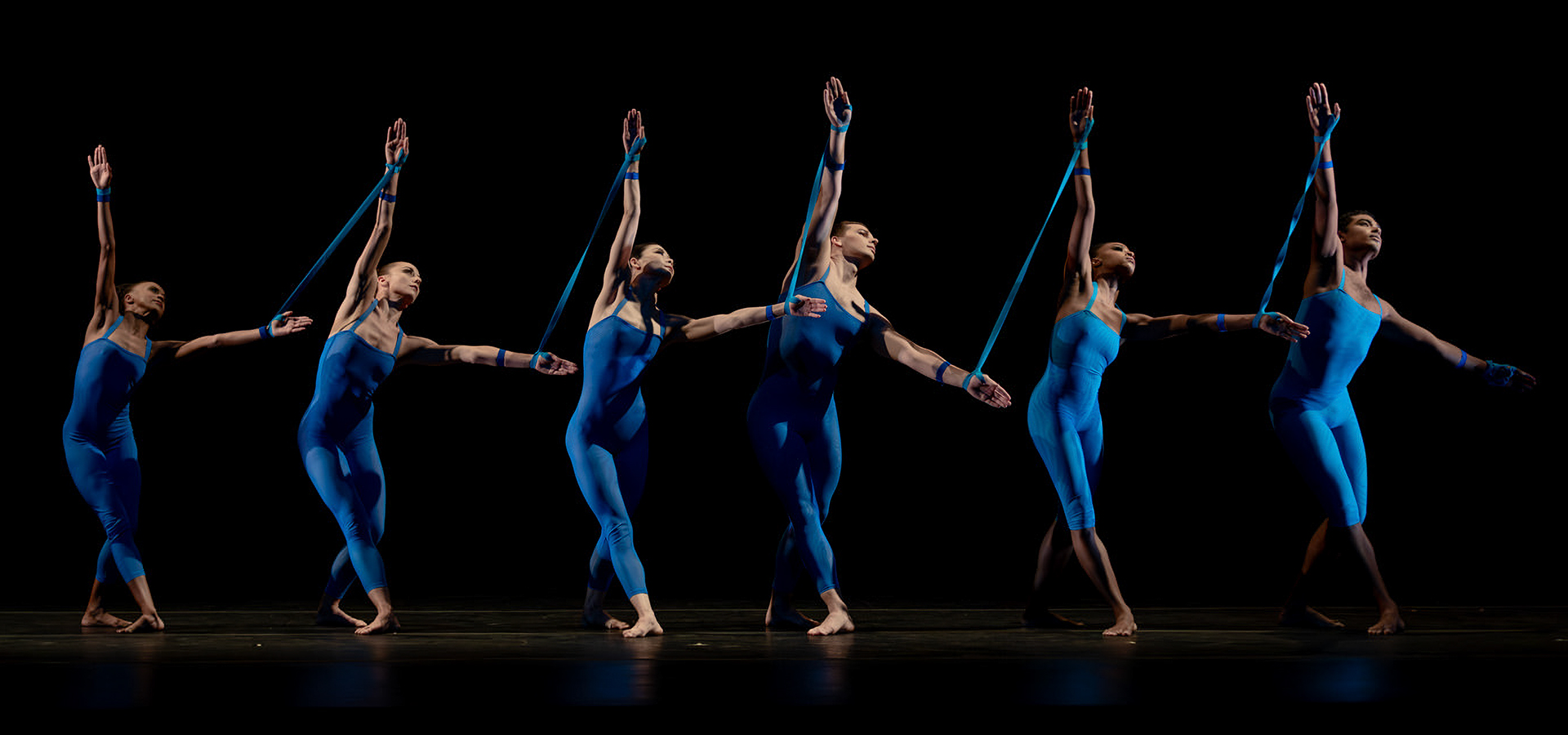
Martha Graham Dance Company Celebrates 100 Years of Revolutionizing Modern Dance
Martha Graham’s connection with UC Berkeley dates back further than the creation of her own company! Learn more about this revered company and its iconic founder.
By Mark Van Oss, Cal Performances’ Communications Editor
Pictured at top: Martha Graham Dance Company in Hope Boykin’s En Masse (Luis Luque)
Celebrating its 100th anniversary, the legendary Martha Graham Dance Company returns to Zellerbach Hall for the first time in more than 10 years with performances on Saturday and Sunday, February 14–15, 2026. Programs include classic Graham works such as the iconic Appalachian Spring, the psychological thriller Night Journey, and the anti-war protest Chronicle—all featuring Isamu Noguchi’s original sets—alongside newly commissioned dances by some of today’s most compelling choreographers.
Saturday evening’s performance features Cortege, a new work by the in-demand team of Baye & Asa, created in response to Graham’s seminal war protest Cortege of Eagles. And Sunday’s matinee includes the Bay Area premiere of En Masse by Alvin Ailey American Dance Theater alum Hope Boykin, as well as Jamar Roberts’ We the People, a collaboration—part lament, part protest—with roots musician Rhiannon Giddens exploring themes of determination and resistance.
“It’s an extraordinary honor to welcome the Martha Graham Dance Company back to Cal Performances,” said Cal Performances Executive and Artistic Director Jeremy Geffen. “Many in our audience remember with admiration the company’s previous visits, stretching from 1970 to their most recent Berkeley appearances in 2014, and the February 2026 engagements offer Bay Area dance lovers the chance to re-engage with seminal works that have defined the company’s past, along with the newly commissioned work—from some choreographers already known to our audiences—that will shape its future. All of this combines to provide a truly not-to-be-missed highlight of the 2025–26 season.”
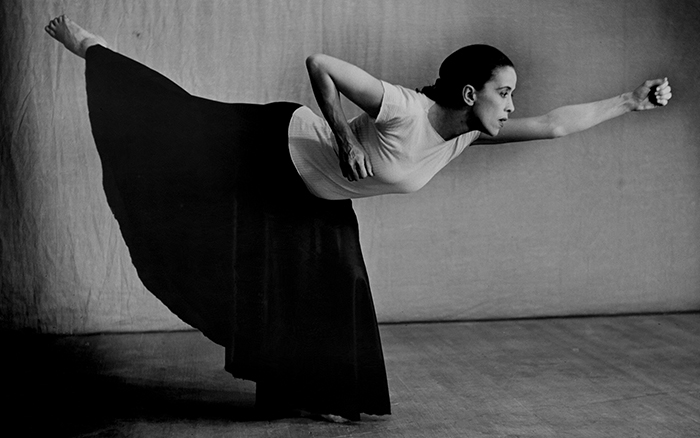
Pictured: Martha Graham performs her work Immediate Tragedy
Martha Graham’s connection with UC Berkeley dates back more than a century, to July 1916, when Ruth St. Denis and Ted Shawn—then at the leading edge of the emerging modern dance movement in the United States—brought their Denishawn company to the Greek Theatre for a special Dance Pageant of Egypt, Greece and India program. That performance featured 170 dancers accompanied by the San Francisco Symphony and the UC Chorus; present on stage, a promising 22-year-old dancer named Martha Graham, in what is believed to be her San Francisco Bay Area debut.
The rest, of course, is history. Today, Graham is recognized—alongside figures such as James Joyce, Pablo Picasso, Igor Stravinsky, and Frank Lloyd Wright—as a primal artistic force of the 20th century. Her distinctive, groundbreaking movement technique has been carried in dancers’ bodies for generations; the works she commissioned have grown and multiplied over hundreds of performances; and her contributions to the art of stage design and dance production are countless.
Indeed, Graham’s name would become synonymous with American modern dance and her school and company would grow to become the training ground for the next generation of American dancers and choreographers, including such luminaries as Merce Cunningham, Pearl Lang, Paul Taylor, Glen Tetley, and Alvin Ailey, all of whom would also form companies and play major roles in the emerging dance programming on the UC Berkeley campus.
Graham founded her company and school in 1926, while living and working out of a tiny Carnegie Hall studio in midtown Manhattan. As early as the 1930s, her dancers reflected diverse cultural backgrounds, and Graham’s commitment to experimentation and attention to contemporary social, political, psychological, and gender issues has forever altered the scope and direction of the art form.
For full program information as well as tickets to Martha Graham Dance Company in GRAHAM100: A Celebration of the Company’s 100th Anniversary, visit the event detail page.
Keeping the Rhythm Alive: Third Coast Percussion & Salar Nader Honor Zakir Hussain
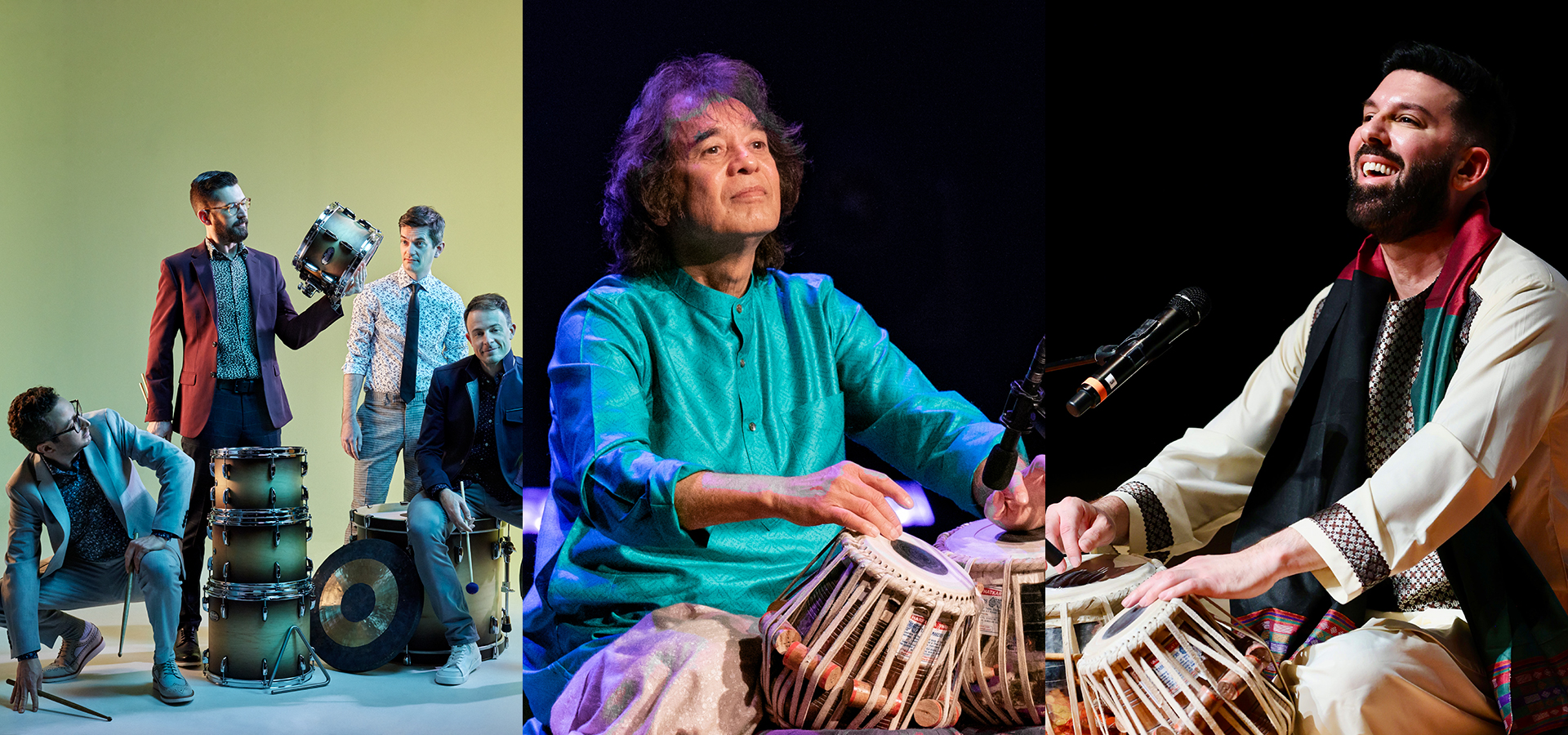
Keeping the Rhythm Alive: Third Coast Percussion & Salar Nader Honor Zakir Hussain
“Almost every musician teaches; it’s a way for their legacy to live on. It lives on in their recordings, their compositions, and their students. This project is special to us because it’s all three aspects of Zakir’s legacy in one evening.”
By Angelina Josephine Rosete, Cal Performances’ Engagement Writer
When Third Coast Percussion (TCP) takes the stage with tabla virtuoso Salar Nader on November 1, the music carries more than melody—it carries memory. Murmurs in Time, the final major work composed by the late Zakir Hussain for the Grammy-winning ensemble, unfolds as both a celebration and continuation of his remarkable legacy. For the musicians, each note is a chance to honor a friend, mentor, and musical visionary whose influence reaches far beyond the stage.
David Skidmore, co-founder and Executive Director of Third Coast Percussion, recalls the ensemble’s long-held admiration for Hussain, who tragically passed away last December. “He was such a generous and humble person, especially when you consider that he really was—in my experience—the finest musician I’ve ever worked with,” he says. TCP had dreamed of collaborating with Hussain for a long time, and when the timing aligned a few years ago, they invited him to compose a work and perform with them. As he was in and out of Chicago touring with other music groups, Hussain would visit TCP’s studio, teaching rhythms, sharing concepts of Hindustani classical music, and leaving the ensemble with ideas to improvise and refine. “We worked together as he was writing the piece,” Skidmore explains. “And this became Murmurs in Time.”
The collaboration offered more than just musical instruction; it was a chance to witness Hussain’s rare ability to connect with musicians and audiences alike. As Skidmore notes, “It’s almost impossible to overstate his impact on the world of percussion.” Earlier this year, TCP was part of a memorial concert for him at Grace Cathedral in San Francisco; it was a gathering of Hussain’s collaborators that highlighted his unique combination of virtuosity and reliability. “That performance really drove home for me how musically and personally he was able to connect with so many different people—whether they were other musicians or audience members; simultaneously, he was able to perform music at a level unlike anyone else and somehow be relatable as a person,” Skidmore recalls. “Such an incredibly rare combination.”
For this performance, the ensemble shares the stage with one of Hussain’s most devoted students: Salar Nader, who began studying under Hussain at the age of 7. “Having the opportunity to meet Salar is one of the many gifts that Zakir left us with,” Skidmore says. “Almost every musician teaches; it’s a way for their legacy to live on. It lives on in their recordings, their compositions, and their students. This project is special to us because it’s all three aspects of Zakir’s legacy in one evening.”
Nader performs Hussain’s part in Murmurs in Time, bringing his own musical take while honoring the rhythms and nuances of his teacher’s work. “We get to see this glimpse of Zakir and his incredible musicianship and legacy through Salar every night,” Skidmore says. The first half of the evening showcases some rhythmically exciting music TCP has been touring with, by composers such as Jessie Montgomery, Tigran Hamasyan, and Jlin; the second half unfolds with a tabla solo composed by Nader in tribute to Hussain, flowing into the masterwork itself—a living dialogue between teacher, student, and ensemble. Reflecting on this experience, Nader shares with us, “I am honored and humbled to be premiering my guru’s composition with Third Coast Percussion at his hometown venue, Zellerbach Hall, and hope that we can carry his spirit in every performance that we do together.”
Beyond technical mastery, Skidmore emphasizes the emotional heart of the performance. “I can’t think of a better way for us to honor his legacy than to continue that; to bring his rhythms and music to audiences we’re meeting on tour,” he shares. “I hope that everyone feels the joy of the music and the joy that we feel performing it.” Hussain shared a long and meaningful relationship with Cal Performances, having regularly performed on its stage for over 20 years. Through his programming, he used his platform to share his own genius, as well as to introduce Berkeley audiences to extraordinary percussionists from a diverse array of musical traditions and backgrounds. For TCP, it is “particularly meaningful to be able to bring this piece that he wrote and this music to the audience that knew him so well,” Skidmore reflects.
Through Murmurs in Time, Third Coast Percussion and Salar Nader offer more than a tribute; they offer continuity. Hussain’s rhythms, teachings, and spirit resonate in every note, reminding audiences that live music has a unique power of preserving memory, inspiring collaboration, and carrying legacies forward—one performance at a time.
Explore More 2025–26 Season Features
Step into Tradition: A Curated Guide to the 2025–26 Season

Step into Tradition: A Curated Guide to the 2025–26 Season
Your cultural matchmaking guide to 2025–26 season highlights.
By Angelina Josephine Rosete, Cal Performances’ Engagement Writer
Looking for your next unforgettable cultural experience? Think of this as a “cultural matchmaking guide,” where your intellectual curiosity about history, tradition, and artistic innovation meets the performances best suited to you. This season, Cal Performances offers a carefully curated lineup that bridges past and present, highlighting the enduring power of artistic legacies while embracing fresh, contemporary interpretations. From the splendor of royal courts to the bold ingenuity of modern dance, from timeless choral masterworks to compelling cultural expressions, there is truly something for everyone—an opportunity to be inspired, challenged, and delighted by the dynamic dialogue that persists between classical artistry and contemporary expression.

If you have ever been captivated by the grandeur of imperial courts, the pageantry of royal ceremonies, or the ways music has shaped cultural heritage, the Vienna Boys Choir offers a window into a living heritage that has spanned over five centuries. Founded in 1498, this remarkable ensemble was originally formed by the Habsburg court, embedding the artistry of young voices into the very fabric of European life. Their repertoire spans centuries, highlighting works that demand precise intonation, clear diction, and the unique tonal purity only boy sopranos and altos can provide. Today, their performances continue to honor that legacy, blending classical masterpieces with carefully curated contemporary works that demonstrate how tradition can evolve without losing its essence.
Attending a Vienna Boys Choir concert is more than simply hearing music—it is experiencing history in motion. Their crystalline harmonies, precision, and youthful energy bring centuries-old compositions vividly to life, connecting audiences to the elegance and sophistication of the past while showcasing the enduring power of music to move and inspire. With each performance, the choir demonstrates mastery of vocal blend, phrasing, and contrapuntal clarity, indications of a practice perfected over generations.

If you are fascinated by the evolution of modern dance and the ways in which movement can express the deepest currents of human emotion, the Martha Graham Dance Company’s centennial program offers a once-in-a-lifetime opportunity. It is impossible to overstate Graham’s influence—her innovative technique of contraction and release, her sculptural use of the body, and her rigorous attention to emotional expressivity have shaped generations of dancers and choreographers.
Returning to Cal Performances for the first time in over a decade, the extraordinary Martha Graham Dance Company celebrates 100 years of her legacy with a program that balances canonical works with contemporary responses. Audiences will experience the iconic Appalachian Spring, a key work of American modern dance; the psychologically intense Night Journey; and the anti-war protest, Chronicle; each performed with Isamu Noguchi’s original sculptural sets that integrate seamlessly with Graham’s choreography. The program also highlights newly commissioned works inspired by Graham’s own pieces.
This performance exemplifies Graham’s lifelong commitment to artistic experimentation and social engagement, continuing her legacy of portraying powerful women, drawing from sources as varied as Greek mythology, Native American ceremonies, and modern art. From the precise articulation of her signature contractions, to the dramatic tension in every phrase of movement, this celebration of the company’s 100th anniversary offers both an immersive historical perspective and a vivid, contemporary reimagining of Graham’s revolutionary contributions to dance. For anyone captivated by the balance of continuity, originality, and expressive power, this program promises an unforgettable encounter with one of the 20th century’s most transformative artistic voices.

The world’s most celebrated interpreters of Renaissance polyphony, the Tallis Scholars return this Easter season with a program illuminating the profound mysteries of Christian faith. Anchoring the evening is Tomás Luis de Victoria’s magnificent Missa O magnum mysterium, surrounded by motets from Thomas Tallis, Giaches de Wert, and Jacobus Gallus. The program bridges five centuries by incorporating works from contemporary Estonian composer Arvo Pärt, whose Tribute to Caesar reflects on Christ’s teachings, while Virgencita presents a modern vision of the Virgin of Guadalupe.
Traditional Renaissance polyphony, the interweaving of multiple melodic vocal lines that became popular in the 15th century, forms the foundation of this repertoire, showcasing a style of music in which each voice contributes to a complex, harmonious texture. For listeners, the draw is not only in hearing these masterpieces live, but in experiencing the clarity, balance, and precision that the Tallis Scholars have perfected over five decades, demonstrating without question the expressive power of polyphony to evoke awe, wonder, and divine mystery.
Founded in 1973 by Peter Phillips, the ensemble has transformed Renaissance sacred music from specialized repertoire into an essential pillar of classical repertoire through over 2,200 concerts and 60+ acclaimed recordings. Phillips’ international recognition and the Tallis Scholars’ crystalline clarity and ethereal unity of voice continue to prove that the greatest expressions of faith speak across centuries with undiminished power. For those who delight in the sonority of interwoven voices, this concert offers a special chance to hear polyphony at its highest level: precise yet human, historical yet immediate, and sacred yet universally moving.
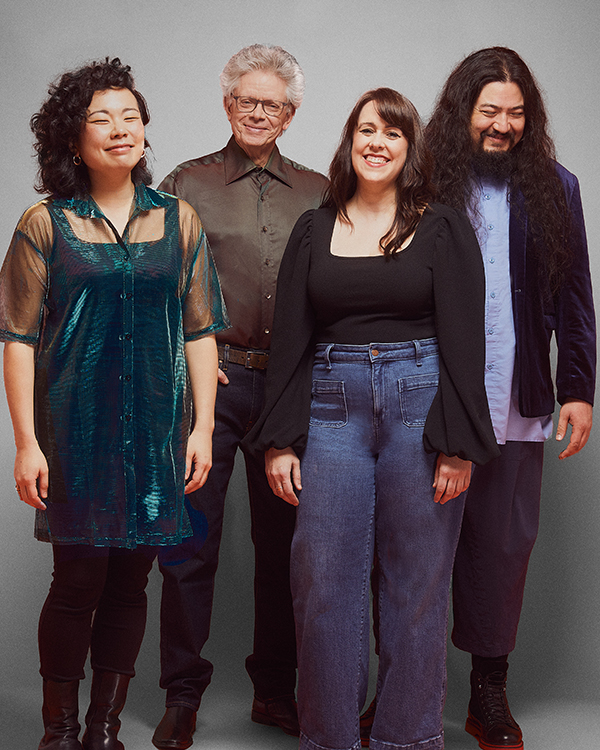
For 50 years, San Francisco’s Kronos Quartet has redefined what a string quartet can be—pushing the form beyond its Western European roots to become a living, evolving art that engages with the people and issues of our time. Their impact spans thousands of concerts, recordings, and commissioned works, but their upcoming performance at Cal Performances offers something especially resonant: stories of migration, memory, and belonging told through music.
Joined by the celebrated pipa virtuoso Wu Man and cultural historian David Lei, Kronos presents Beyond the Golden Gate, a far-reaching hybrid presentation that traces Chinese American experiences across generations. From intimate personal reflections to newly commissioned works, the evening highlights how music can carry cultural identity—bridging continents, honoring ancestry, and speaking directly to the present. For audiences curious about the intersection of personal heritage and artistic innovation, this performance is more than a concert; it is a portrait of cultural resilience. Kronos’s legacy reminds us that string quartets are not only keepers of tradition, but also vital storytellers reminding us of who we are and where we come from.
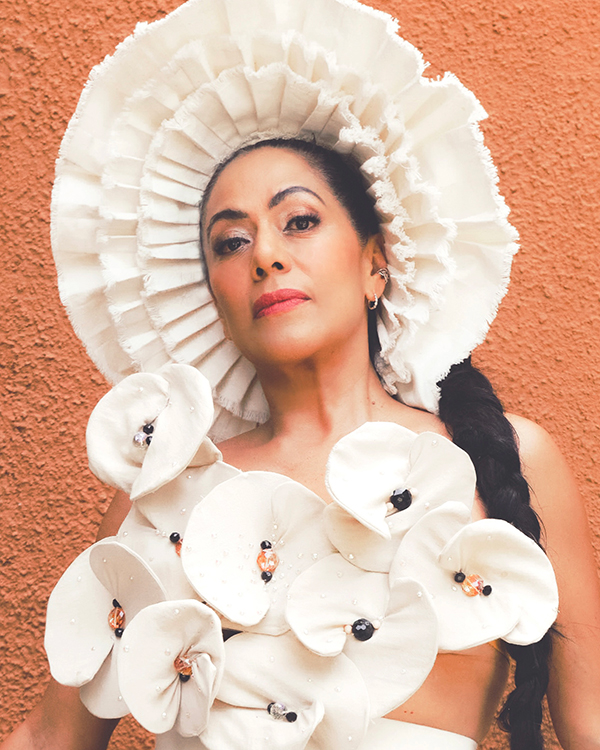
Experience the vibrant celebration of Día de los Muertos with Lila Downs, the Grammy- and Latin Grammy-winning singer whose artistry is deeply rooted in her Mixtec heritage. Audiences who love storytelling through music will be captivated by Downs’ seamless blending of traditional songs, original compositions, and performances in Spanish, English, and the indigenous languages of Oaxaca. Backed by a dynamic all-star band, her commanding voice and stage presence turn each song into an immersive, celebratory experience, making the past feel alive in the present—the perfect atmosphere for a holiday dedicated to honoring and remembering loved ones who have passed on. This is a performance for anyone eager to experience music that bridges generations, honors ancestral legacies, and traces rich cultural traditions—making it both an unforgettable experience and deeply moving moment.
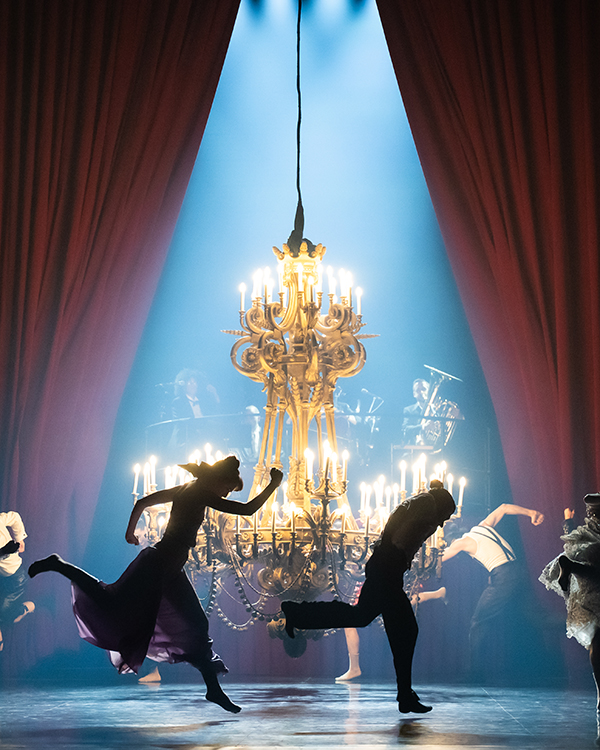
For those captivated by classical ballet’s rich heritage, the Paris Opera Ballet offers a rare glimpse into a company whose artistry stretches back to the era of Louis XIV. But in Red Carpet, tradition meets a thrillingly modern vision: UK-based choreographer Hofesh Shechter transforms the stage into a world where classical precision collides with dynamic, emotionally charged movement.
The choreography fuses disciplined technique with bold, raw gestures, creating a performance that is both technically masterful and intensely expressive. Audiences will be drawn into a visually striking spectacle, complete with moving catwalks, a monumental chandelier, and CHANEL-designed costumes inspired by evening wear and cabaret, balancing glamour with grit. Shecter and Yaron Engler’s original score, performed live and blending free jazz, Mediterranean influences, and pulsing techno rhythms, amplifies the energy and immediacy of the dance. This singular West Coast performance offers an incredibly unique opportunity to witness a company at the forefront of ballet, where centuries-old traditions are reinvigorated with daring, contemporary artistry. Far from conventional ballet, Red Carpet fuses rigorous classical technique with bold, modern movement, creating a performance that is as exhilarating and provocative as it is breathtaking.
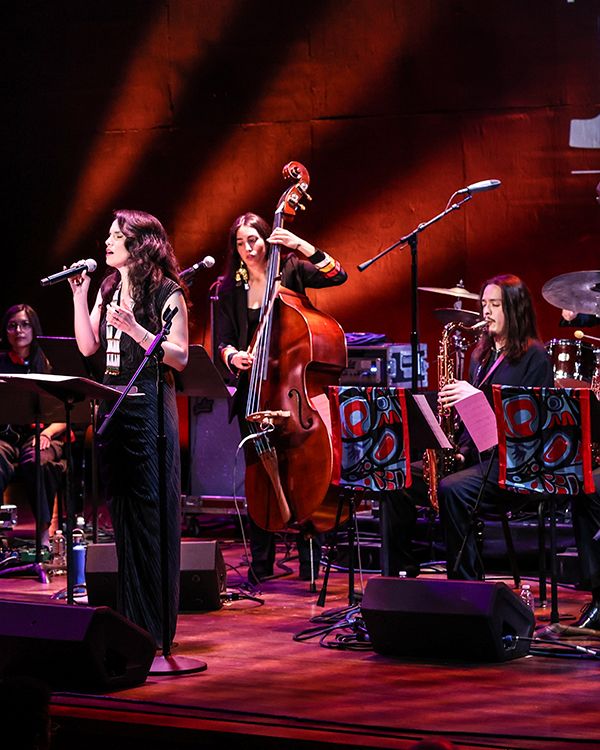
The Julia Keefe Indigenous Big Band offers a rare and vital perspective on jazz, illuminating a long-overlooked chapter of the genre’s history. Emerging from a legacy shaped by resilience and creativity, Indigenous musicians have long contributed to jazz as vibrant ensembles and big bands flourished across the US and Canada in the early twentieth century. Yet, despite their talent and influence, their contributions were often uncredited, and their influence unrecognized.
Guided by composer and arranger Julia Keefe and co-founder Delbert Anderson, this ensemble celebrates that legacy while forging new paths. Drawing on traditional songs, rhythms, and stories from Indigenous cultures spanning North and South America, the band reimagines them through the language of jazz, creating a repertoire that is both rooted in heritage and electrifyingly contemporary. Each performance honors the past while uplifting the next generation of Indigenous jazz musicians, blending virtuosity, improvisation, and cultural narratives into a singular musical experience. For listeners, this is more than a concert—it is a journey through history, identity, and innovation, showcasing the depth, diversity, and enduring vitality of Indigenous contributions to jazz.
From the rich layers of choral harmonies to the striking force of modern dance, this season’s lineup demonstrates that the arts are living, evolving dialogues between past and present. Each performance invites audiences to step into a world shaped by legacy, originality, and cultural memory—whether through the reinterpretation of ancestral music, the reinvention of classical forms, or the celebration of identity. These experiences remind us that curiosity, openness, and a willingness to explore new perspectives are at the heart of truly engaging with the arts. No matter your passion—whether it be history, cultural storytelling, or artistic experimentation—there is a performance waiting to ignite your imagination and expand your understanding of the world around you.
Related Events
Explore More 2025–26 Season Features
“Exile & Sanctuary”: The Politics of Hospitality

“Exile & Sanctuary”: The Politics of Hospitality
History of the Sanctuary Movement in the US
Produced and directed by Mina Girgis, Cal Performances’ Director of Education, Campus and Community Engagement; Directed and edited by Lindsay Gauthier. Full credits below.
Cal Performances’ 2025–26 season of Illuminations programming draws from the performing arts and UC Berkeley scholarship to explore the theme of “Exile & Sanctuary.” Hospitality has long been a fundamental ethic across cultures, yet in modern times, it has become a flashpoint of political debate. The Sanctuary Movement—born not from progressive politics but from conservative Christian values—offers a surprising origin story for today’s struggles over migration, refuge, and belonging. In this conversation, we examine how the act of offering sanctuary shifted from a moral obligation to a contested “liberal cause,” and what this history reveals about the power and limits of hospitality in a divided world.
This video features Leti Volpp, PhD, UC Berkeley’s Robert D. and Leslie Kay Raven Professor of Law in Access to Justice; Angela Marino, PhD, UC Berkeley professor of Theater, Dance, and Performance Studies; Stephanie Zonszein, PhD, UC Berkeley professor of Political Science; and Alex Saum-Pascual, PhD, UC Berkeley professor of Spanish and Portuguese, and member of the Executive Board for Berkeley Center for New Media.
For more on our 2025–26 season and our Illuminations programming, visit calperformances.org/illuminations.
Transcript
INTRODUCTION
Leti Volpp:
There’s a saying: “We didn’t cross the border, the border crossed us. We are here because you were there.” In other words, we have migrated to the metropole from the colony because you were colonizing us in the past.
Angela Marino:
So if you’re Campesino and you’re in exile from a condition of violence, you might try to find sanctuary within the United States, but you’re in the heart of the beast looking for sanctuary from the very machinery all the way around that’s never facing what it actually did to cause that immigration in the first place.
Stephanie Zonszein:
For the displaced, even after living in a place for different generations, they’re still confronting the fact that they do not have full access to participation in society, the economy, politics.
Alex Saum-Pascual:
If we are understanding sanctuary as providing safety and protection to somebody who is endangered or feeling any kind of prosecution, it seems like the moral thing to do. It’s common sense. The problem comes when we redefine those people seeking exile as enemies or villains.
THE SANCTUARY MOVEMENT
Leti Volpp:
So the origins of the Sanctuary Movement in the 1980s began because members of religious communities saw that there was terrible violence in Latin America. In particular, the United States was helping arm and fund very repressive regimes in Guatemala and El Salvador. And in the process, almost a million people fled and came to the United States. At the same time, once those Guatemalans and Salvadorans applied for asylum, the rate of approval was between 1 and 3%, while the average rate of approval of asylum generally was about 30%.
Angela Marino:
I remember… a young man coming to my house when I was a kid, and hearing the story of what the paramilitary in El Salvador supported by the United States had done to their family members. It was torture. It was dismemberment. It was the most atrocious cruelty. And that kind of violence that was produced by the state was a condition of exile and sanctuary that was never heard about really in the mainstream of U.S. political discourse or political cultures. It remained something that people have fought for in the interfaith community to bring forward for as a Sanctuary Movement.
Leti Volpp:
So there was this, I think, very well-founded perception, which was that the United States essentially supported these military dictatorships that were producing all of these refugees, who then were not being recognized as actual refugees when they came to the United States. So members of religious organizations started feeding people, sheltering people, transporting people, providing them with legal aid, and there were a number of people who actually were criminally prosecuted for their activities as part of the Sanctuary Movement. So I think their linguistic similarities—obviously colonial regimes bring a language with them that they force the people they’re colonizing to learn, and it becomes the language of colonial administration. There become immigration pathways that exist for people from former colonies that shape why people go to the so-called metropole from the colony.
THE POLITICS OF HOSPITALITY
Stephanie Zonszein:
Starting perhaps in the 1990s, just at the end of the Sanctuary Movement… Before this, we had the two parties taking very similar positions in terms of immigration policy, so both parties would be wanting to give more rights to immigrants who were already in the U.S. But in the 1990s is when we see these two parties diverging in their policies, voters now starting to understand then immigration policy and immigration in general as something that is politicized: If you support the Democratic Party, then you’re liberal, and then you’re supporting more inclusionary policies If you’re supporting the Republican Party, then you’re not.
Alex Saum-Pascual:
I think “hospitality,” like any other word, can be activated to mean many different things that serve different intentions and with different power structures behind. So, when polarization is thriving and creating a certain battle over meaning, “hospitality” will be a word that can be activated to mean its complete opposite even.
Leti Volpp:
To whether or not I think of sanctuary as essentially a liberal act, I feel like it’s a human act. It’s a humane act. It’s recognizing that the stranger is the neighbor, is potentially the loved one.
Alex Saum-Pascual:
You could think of that as “liberal politics,” but if you’re thinking about just aiding people to escape possible death, it just seems the moral thing to do. There’s nothing inherently “liberal” about that.



